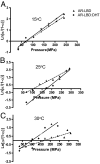Kinetic and thermodynamic characterization of dihydrotestosterone-induced conformational perturbations in androgen receptor ligand-binding domain
- PMID: 19443608
- PMCID: PMC2718745
- DOI: 10.1210/me.2008-0304
Kinetic and thermodynamic characterization of dihydrotestosterone-induced conformational perturbations in androgen receptor ligand-binding domain
Abstract
Ligand-induced conformational perturbations in androgen receptor (AR) are important in coactivator recruitment and transactivation. However, molecular rearrangements in AR ligand-binding domain (AR-LBD) associated with agonist binding and their kinetic and thermodynamic parameters are poorly understood. We used steady-state second-derivative absorption and emission spectroscopy, pressure and temperature perturbations, and 4,4'-bis-anilinonaphthalene 8-sulfonate (bis-ANS) partitioning to determine the kinetics and thermodynamics of the conformational changes in AR-LBD after dihydrotestosterone (DHT) binding. In presence of DHT, the second-derivative absorption spectrum showed a red shift and a change in peak-to-peak distance. Emission intensity increased upon DHT binding, and center of spectral mass was blue shifted, denoting conformational changes resulting in more hydrophobic environment for tyrosines and tryptophans within a more compact DHT-bound receptor. In pressure perturbation calorimetry, DHT-induced energetic stabilization increased the Gibbs free energy of unfolding to 8.4 +/- 1.3 kcal/mol from 3.5 +/- 1.6 kcal/mol. Bis-ANS partitioning studies revealed that upon DHT binding, AR-LBD underwent biphasic rearrangement with a high activation energy (13.4 kcal/mol). An initial, molten globule-like burst phase (k approximately 30 sec(-1)) with greater solvent accessibility was followed by rearrangement (k approximately 0.01 sec(-1)), leading to a more compact conformation than apo-AR-LBD. Molecular simulations demonstrated unique sensitivity of tyrosine and tryptophan residues during pressure unfolding with rearrangement of residues in the coactivator recruitment surfaces distant from the ligand-binding pocket. In conclusion, DHT binding leads to energetic stabilization of AR-LBD domain and substantial rearrangement of residues distant from the ligand-binding pocket. DHT binding to AR-LBD involves biphasic receptor rearrangement including population of a molten globule-like intermediate state.
Figures









Similar articles
-
Dynamic communication between androgen and coactivator: mutually induced conformational perturbations in androgen receptor ligand-binding domain.Proteins. 2011 Apr;79(4):1154-71. doi: 10.1002/prot.22951. Epub 2011 Feb 14. Proteins. 2011. PMID: 21322031
-
Dynamics of coregulator-induced conformational perturbations in androgen receptor ligand binding domain.Mol Cell Endocrinol. 2011 Jul 20;341(1-2):1-8. doi: 10.1016/j.mce.2011.03.003. Epub 2011 May 14. Mol Cell Endocrinol. 2011. PMID: 21605623
-
Communication between the Ligand-Binding Pocket and the Activation Function-2 Domain of Androgen Receptor Revealed by Molecular Dynamics Simulations.J Chem Inf Model. 2019 Feb 25;59(2):842-857. doi: 10.1021/acs.jcim.8b00796. Epub 2019 Feb 6. J Chem Inf Model. 2019. PMID: 30658039
-
Partial androgen insensitivity and correlations with the predicted three dimensional structure of the androgen receptor ligand-binding domain.Mol Cell Endocrinol. 1998 Feb;137(1):41-50. doi: 10.1016/s0303-7207(97)00229-3. Mol Cell Endocrinol. 1998. PMID: 9607727 Review.
-
Peptide antagonist of the androgen receptor.Curr Pharm Des. 2010;16(9):1106-13. doi: 10.2174/138161210790963850. Curr Pharm Des. 2010. PMID: 20030610 Review.
Cited by
-
Androgen receptor gene rearrangements: new perspectives on prostate cancer progression.Curr Drug Targets. 2013 Apr;14(4):441-9. doi: 10.2174/1389450111314040005. Curr Drug Targets. 2013. PMID: 23410127 Free PMC article. Review.
-
Endocrine Disrupting Chemicals Mediated through Binding Androgen Receptor Are Associated with Diabetes Mellitus.Int J Environ Res Public Health. 2017 Dec 23;15(1):25. doi: 10.3390/ijerph15010025. Int J Environ Res Public Health. 2017. PMID: 29295509 Free PMC article. Review.
-
Pressure perturbation calorimetry of lipoproteins reveals an endothermic transition without detectable volume changes. Implications for adsorption of apolipoprotein to a phospholipid surface.Biochemistry. 2011 May 17;50(19):3919-27. doi: 10.1021/bi200090y. Epub 2011 Apr 20. Biochemistry. 2011. PMID: 21452855 Free PMC article.
-
Antidiabetic phospholipid-nuclear receptor complex reveals the mechanism for phospholipid-driven gene regulation.Nat Struct Mol Biol. 2012 Apr 15;19(5):532-S2. doi: 10.1038/nsmb.2279. Nat Struct Mol Biol. 2012. PMID: 22504882 Free PMC article.
-
Endocrine-disrupting chemicals and public health protection: a statement of principles from The Endocrine Society.Endocrinology. 2012 Sep;153(9):4097-110. doi: 10.1210/en.2012-1422. Epub 2012 Jun 25. Endocrinology. 2012. PMID: 22733974 Free PMC article.
References
-
- Quigley CA, De Bellis A, Marschke KB, el-Awady MK, Wilson EM, French FS 1995 Androgen receptor defects: historical, clinical, and molecular perspectives. Endocr Rev [Erratum (1995) 16:546] 16:271–321 - PubMed
-
- Brinkmann AO, Klaasen P, Kuiper GG, van der Korput JA, Bolt J, de Boer W, Smit A, Faber PW, van Rooij HC, Geurts van Kessel A, Mulder E, Trapman J 1989 Structure and function of the androgen receptor. Urol Res 17:87–93 - PubMed
-
- Gobinet J, Poujol N, Sultan Ch 2002 Molecular action of androgens. Mol Cell Endocrinol 198:15–24 - PubMed
-
- Bhasin S, Cunningham GR, Hayes FJ, Matsumoto AM, Snyder PJ, Swerdloff RS, Montori VM 2006 Testosterone therapy in adult men with androgen deficiency syndromes: an endocrine society clinical practice guideline. J Clin Endocrinol Metab 91:1995–2010 - PubMed
-
- Bhasin S 2007 Testicular disorders. In: Kronenberg H, Polonsky KS, Larsen PR, Melmed S, eds. Williams’ textbook of endocrinology. 11th ed. New York: Elsevier Health Sciences
Publication types
MeSH terms
Substances
Grants and funding
LinkOut - more resources
Full Text Sources
Research Materials
Miscellaneous

